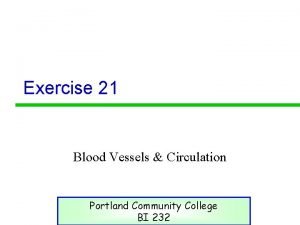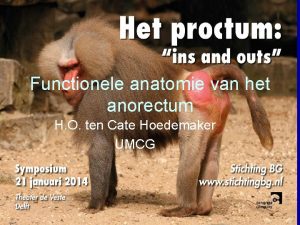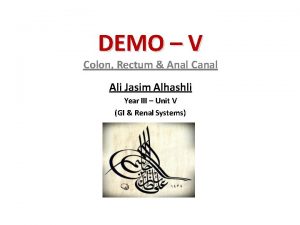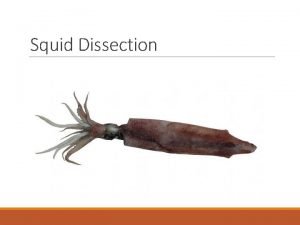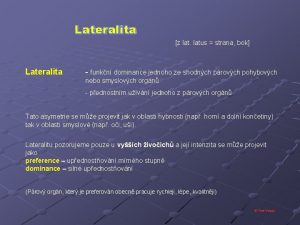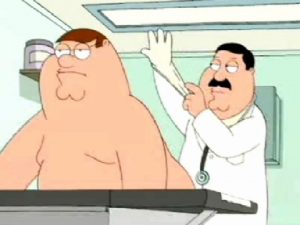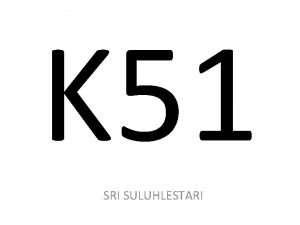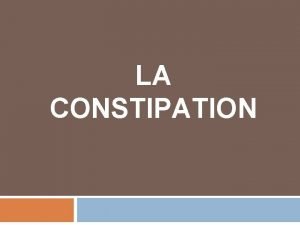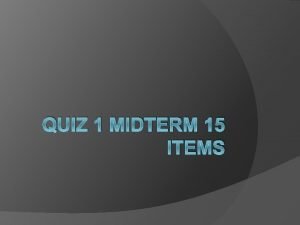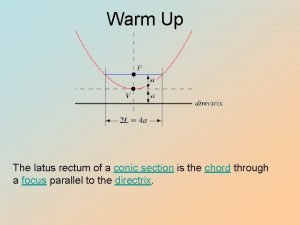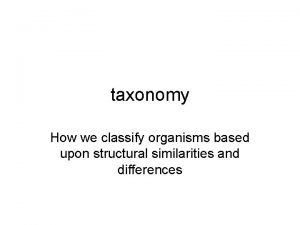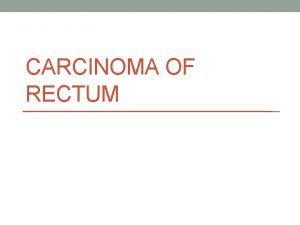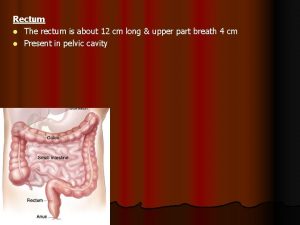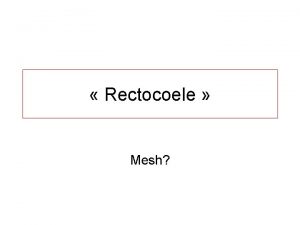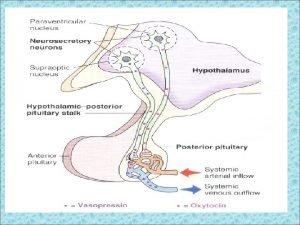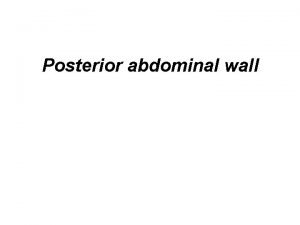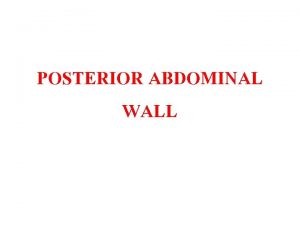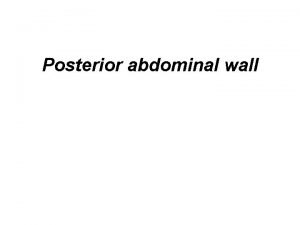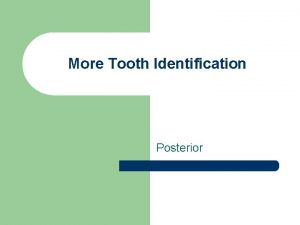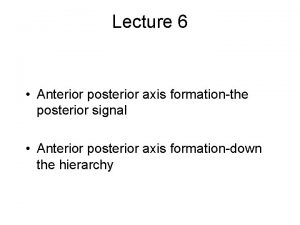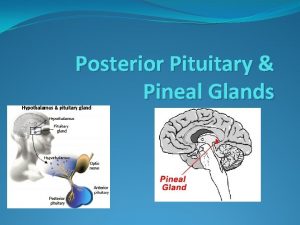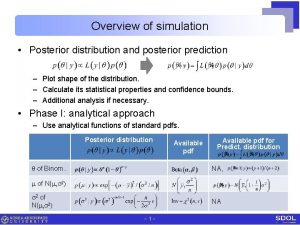RECTUM LOCATION The rectum is the most posterior













































- Slides: 45

RECTUM (LOCATION) The rectum is the most posterior part of the pelvic viscera. It begins in front of the 3 rd sacral vertebra. As a continuation of the sigmoid colon. n n n

RECTUM (LOCATION) It pierces the pelvic n diaphragm and continues with the anal canal in front of the tip of the coccyx. Its lower end is n dilated to form the rectal ampulla.

ANORECTALJUNCTION It bends downwards and backwards at its junction with the anal canal. It is pulled forwards by the puborectalis part of the levator ani. The anal canal n moves in a posterior direction. n n

DESCRIPTION The rectum follows the anterior concavity of the sacrum. It has three lateral n curvatures. The upper and lower to the right. The middle to the left. n n n

PERITONEUM Upper 1/3 : n Covered on the front and sides. Middle 1/3 : n Covered on the front. Lower 1/3 : n Devoid of n peritoneum. n n

MUSCULAR COAT The longitudinal n muscle fibers form a broad band on the anterior and posterior surfaces.

MUCOUS MEMBRANE With the circular muscle layer, it forms three transverse folds of the rectum. n

DESCRIPTION Unlike the colon, n the rectum lacks: Taeniae coli. n Appendices. n Sacculations. n

POSTERIOR RELATIONS Bones : n Sacrum and coccyx. n Muscles : n Piriformis. n Coccygeus. n Levator ani. n Nerves : n Sacral plexus. n Sympathetic trunk. n

ANTERIOR RELATIONS (MALE) The upper 2/3 (covered n by peritoneum) related to: The rectovesical pouch n and its contents (coils of ileum & sigmoid colon). Lower 1/3 : n Posterior surface of the n bladder. Prostate. n Termination of the vas n deferens and seminal vesicle.

ANTERIOR RELATIONS (FEMALE) Upper 2/3 : n Rectouterine n (Douglas pouch) and its contents. Lower 1/3 : n Posterior surface of the vagina. n

ARTERIAL SUPPLY (1) Superior rectal n artery : It is the main arterial supply to the mucous membrane. It is the direct n continuation of the inferior mesenteric artery. It divides into right n and left branches. n

ARTERIAL SUPPLY (2) Middle rectal : n It arises from the n internal iliac. It supplies the n muscular coat. (3) Inferior rectal: n It arises from the n internal pudendal. It anastomoses with the middle rectal. n

VENOUS DRAINAGE The veins follow their n arteries. They drain to the n following veins respectively : Inferior mesenteric. n Internal iliac. n Internal pudendal n The union of the rectal n veins form an important porto systemic anastomoses.

INTERNAL HEMORRHOIDS The superior rectal n vein divides into right and left branches. The right branch n redivides into anterior and posterior branches. Internal hemorroides are two on the right side and one on the left.

LYMPH DRAINAGE Pararectal lymph nodes. n Upper part : n Follows the superior n mesenteric artery to inferior mesenteric nodes. Lower part : n Follows middle rectal n artery to the internal iliac nodes. n

NERVE SUPPLY The rectum is n sensitive to stretch only. Its sympathetic n and parasympathetic supply is from the inferior hypogastric plexus.

PELVIC PART OF URETER (MALE) It enters the pelvis by crossing the bifurcation of the common iliac vessels in front of sacroiliac joint. It descends in front of the internal iliac artery along the lateral pelvic wall. n n

PELVIC PART OF URETER (MALE) At the ischial spine: n It turns forwards. n At its termination: n It is crossed by the n vas deferens. It enters the lateral n angle of the bladder.

PELVIC PART OF URETER (FEMALE) It runs downwards n and backwards in front of the internal iliac artery and behind the ovary. At the ischial spine: n It lies beneath the n broad ligament. It is crossed by the n uterine artery.

URINARY BLADDER It is the most n anterior pelvic viscera (just behind the pubic bones).

POSITION (ADULTS) The empty n bladder: Is a pelvic organ. The full bladder: Expands superiorly into the abdomen. n n

POSITION (CHILDREN) The empty n bladder projects above the pelvic inlet because of the small sized pelvic cavity.

SHAPE It is a three sided n pyramid that lies on one of its margins. It has: n Apex. n Base. n Neck. n Superior and two n Inferolateral surfaces.

APEX Lies behind the n upper margin of the symphsis pubis. It is directed n anteriorly. The median n umbilical ligament (remnant of urachus) connects it to the umbilicus.

BASE (POSTERIOR SURFACE) It faces n posteroinferiorly. It is shaped like an n inverted triangle. The two ureters enter the bladder at each of the upper corners of the base. The urethra drains n inferiorly from the lower corner. n n

BASE The terminal parts of the two vasa differentia lie side by side on the posterior surface. They separate the n seminal vesicles from each other. n

BASE (POSTERIOR SURFACE) The peritoneum covers its upper part. It forms the n anterior layer of the rectovesical pouch. n

BASE (POSTERIOR SURFACE) The lower part is n separated from the rectum by: Rectovesical fascia. Vasa differentia. n Seminal vesicles.

POSTERIOR SURFACE (IN FEMALE) Is separated n from the rectum by the vagina.

SUPERIOR SURFACE It is covered by n peritoneum. It is related to coils of n ileum or sigmoid colon. Laterally, the peritoneum is reflected onto the lateral pelvic walls. It forms the paravesical n fossae. n

SUPERIOR SURFACE (IN FEMALE) It is covered by n peritoneum. It is related to: n Uterovesical pouch. Body of uterus. n

INFEROLATERAL SURFACES Anterior : n Retropubic pad of n fat. Pubic bones. n Posterior : n Obturator internus n (above). Levator ani (below). n

NECK It is the most inferior n part of the bladder. It surrounds the origin n of the urethra (at the meeting of the inferolateral surfaces and the base).

NECK It rests on the upper n surface of the prostate. It is held in position n by a pair of fibromuscular bands (Puboprostatic) ligament. It is the most fixed n part of the bladder.

NECK (IN FEMALE) The bladder lies at a lower level because of the absence of the prostate. The neck rests on the upper surface of the urogenital diaphragm. n n

NECK (IN FEMALE) It is held in position by: Pubovesical ligaments. n

FULL BLADDER The posterior n surface and the neck remain unchanged in position. Only the superior surface rises into the abdomen. n

MUCOUS MEMBRANE Mostly in the n empty bladder, it is thrown into folds. These disappear n when the bladder is full.

TRIGONE Its mucous membrane n is always smooth because it is firmly adherent to the underlying muscular coat. It is limited above by n the interureteric ridge (from the opening of one ureter to the other).

UVULA VESICAE It is a small n elevation immediately behind the urethral orifice. It is produced by the median lobe of the prostate. n

SUPPORT OF THE BLADDER It depends on : n 1) The Puboprostatic & Pubovesical ligaments. (2) Levator ani n muscles. (3) Pubic bones. n (4) Perineal n membrane and the associated muscles. n

ARTERIAL SUPPLY In male : n Superior & inferior vesical arteries. In female : n Superior vesical & vaginal arteries. n n

VENOUS DRAINAGE Vesical plexus. n It drains into: n prostatic plexus (in male). Vaginal plexus n (in female). Internal iliac vein. n

NERVE SUPPLY Sympathetic : n Inferior hypogastric plexus. Parasympathetic : n Pelvic splanchnic n nerves. n
 Elastic artery examples
Elastic artery examples Vascularisatie rectum
Vascularisatie rectum Rectum and anal canal
Rectum and anal canal Lacteals function
Lacteals function Squid
Squid Latus rectum
Latus rectum Rectum extraperitoneal
Rectum extraperitoneal Rectum in men
Rectum in men Ulcerative colitis, unspecified
Ulcerative colitis, unspecified Rectum
Rectum What is sims position used for
What is sims position used for Lymphoid nodule colon
Lymphoid nodule colon Latus rectum of parabola
Latus rectum of parabola A cross country skier moves from location a to location b
A cross country skier moves from location a to location b Location planning management
Location planning management In the name of allah the most gracious the most merciful
In the name of allah the most gracious the most merciful In the name of allah, the most gracious, the most merciful
In the name of allah, the most gracious, the most merciful In the name of god the most gracious the most merciful
In the name of god the most gracious the most merciful Most general to most specific classification
Most general to most specific classification In the name of allah the most
In the name of allah the most The most
The most In the name of allah the beneficent the merciful
In the name of allah the beneficent the merciful The arrangement chapter 9
The arrangement chapter 9 Most general to most specific classification
Most general to most specific classification The most gracious
The most gracious Beneficent pronunciation
Beneficent pronunciation In the name of god most gracious most merciful
In the name of god most gracious most merciful Most general to most specific classification
Most general to most specific classification The most gracious
The most gracious Guddi baji
Guddi baji Nguyên nhân của sự mỏi cơ sinh 8
Nguyên nhân của sự mỏi cơ sinh 8 Trời xanh đây là của chúng ta thể thơ
Trời xanh đây là của chúng ta thể thơ Chó sói
Chó sói Thiếu nhi thế giới liên hoan
Thiếu nhi thế giới liên hoan Phối cảnh
Phối cảnh Một số thể thơ truyền thống
Một số thể thơ truyền thống Thế nào là hệ số cao nhất
Thế nào là hệ số cao nhất Sơ đồ cơ thể người
Sơ đồ cơ thể người Ng-html
Ng-html So nguyen to
So nguyen to Tư thế ngồi viết
Tư thế ngồi viết đặc điểm cơ thể của người tối cổ
đặc điểm cơ thể của người tối cổ Mật thư anh em như thể tay chân
Mật thư anh em như thể tay chân Các châu lục và đại dương trên thế giới
Các châu lục và đại dương trên thế giới Chụp tư thế worms-breton
Chụp tư thế worms-breton ưu thế lai là gì
ưu thế lai là gì
